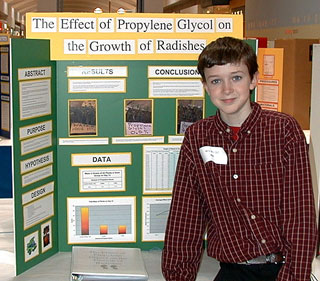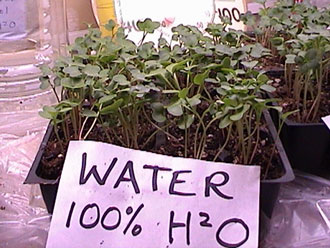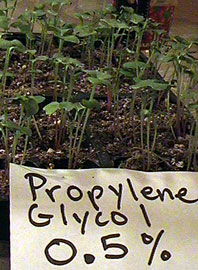| The Effect
of Propylene Glycol on the Growth of Radishes |

Researched by Joel F.
2002-03 |
|
PURPOSE
The purpose of this experiment was to determine the effect of various
concentrations of propylene glycol antifreeze on the growth rate of radishes.
I became interested in this idea when my moms radishes that were watered
with irrigation water died. I wondered if there were some pollutants, like
antifreeze, in the water.
The information gained from this experiment will benefit farmers, scientists,
and botanists. It will help them by showing them how different amounts
of antifreezes effect radishes.
HYPOTHESIS
My hypothesis was that the greater the concentration of propylene glycol
used to water radishes, the less they would grow.
I based my hypothesis on the fact that propylene glycol is poisonous
and an ounce is capable of killing young children. Although propylene glycol
is supposed to be less toxic than ethylene glycol, I still think it will
harm or kill the radishes.
EXPERIMENT DESIGN
The constants in this study were:
-
The type of plant used.
-
The amount of plants used.
-
The amount of water used.
-
The amount of Sierra antifreeze used on the 1.0% group.
-
The amount of Sierra antifreeze used on the 0.5% group.
-
The type of planting pot.
-
The type of planting soil used.
-
The amount of lamplight.
-
The temperature.
The manipulated variable was the concentration of antifreeze used
on the radishes.
The responding variable was the mass of the radishes.
To measure the responding variable I weighed each group of radishes
using a triple beam balance.
MATERIALS
| QUANTITY |
ITEM DESCRIPTION |
| 216 |
Radish seeds: "Red Devil" small, tiny, brown seeds. |
| 180 |
Potting cups: Small, black, and plastic cups with holes on the bottom. |
| 1 bag |
Planting soil. |
| 1 |
Plastic sheet, large and clear, about 8 by 20. |
| 5 gallons |
1.0% propylene glycol and 99.0% H2O. |
| 5 gallons |
0.5% propylene glycol and 99.5% H2O. |
| 10 gallons |
100.0% H2O |
| 1 |
Small plastic sheet about 5 by 6. |
| 1 |
heat lamp |
.
PROCEDURES
1. Prepare the work station.
A. Find a large workspace away from children, animals and pets.
B. Clear off the large space of any and all foreign objects.
C. Lay the small plastic sheet over your workspace.
D. Poke holes on the bottom of the planting cups so that the excess
water and antifreeze can drain out. (Remember to dispose of the water and
antifreeze -that drained out- properly.)
E. Place the planting cups on top of the plastic.
F. Hang a heat lamp over the planting cups.
G. Hang the large plastic sheet around the workspace so that the heat
will stay inside the workspace.
2. Prepare the planting cups.
A. Divide the cups into four groups.
B. Fill the cups with enough planting soil so that its about one eighth
of an inch away from the top of the cup.
C. Plant 4 radish seeds in each cup then cover them up.
D. Label each group with a piece of cardboard.
E. Write the treatment each group should get on the card in pen.
i. Group one needs 1.0% propylene glycol and 99.0% H2O.
ii. Group two needs 0.5% propylene glycol and 99.5% H2O.
iii. Group three needs 100.0% H2O.
iv. Group four needs 100.0% H2O.
3. Make a list to show which group has what amount of antifreeze in
it.
4. The heat lamp should be left on all day and night.
5. Create the 1.0% propylene glycol mixture.
A. Fill 9 graduated cylinders up to the 100 ml marker with pure water
ad pour them in to the 1.0% propylene glycol container.
B. Fill a tenth cylinder up to the 90 ml marker with pure water and
add it to the 1.0% propylene glycol container.
C. Then fill the other graduated cylinder with propylene glycol up
to the 10 ml marker and add it to the 1.0%propylene glycol container.
6. Create the 0.5% propylene glycol mixture.
A. Fill 9 graduated cylinders up to the 100 ml marker with pure water
ad pour them in to the 0.5% propylene glycol container.
B. Fill a tenth cylinder up to the 95 ml marker with pure water and
add it to the 0.5% propylene glycol container.
C. Then fill the other graduated cylinder with propylene glycol up
to the 5 ml marker and add it to the 0.5%propylene glycol container.
7. Water the first and second group with water containing propylene
glycol.
A. The first group needs 0.5% of propylene glycol.
B. The second group needs 1.0% of propylene glycol.
8. The third group needs its water to be 100.0% H2O.
9. Water each group with 5 ml of the water it should get. Keep concentration
of propylene glycol and H2O constant within each group.
10. Check daily for signs of growth. Record any and all data on growth
rate.
11. Repeat step 9-11 Then fill the other graduated cylinder with propylene
glycol up to the 10 ml marker and add it to the 1.0%propylene glycol container.
until any group dies and stops growing.
12. Pull out radishes when one of the groups has died.
13. Record the mass of each group.
14. Average and graph the mass of each group.
15. Each plant should be recorded in its own groups graph.
RESULTS
The original purpose of this experiment was to determine the effect
of various amounts of propylene glycol antifreeze on the growth rate of
radishes.
The results of the experiment were that group two which was watered
with 1.0% propylene glycol grew poorly and many died. Also group one which
was watered with 0.5% propylene glycol grew poorly although better than
the 1.0% group. They also looked like they were on the verge of dieing.
 
See my tables
and graphs.
CONCLUSION
My hypothesis was that the greater the concentration of propylene glycol
used to water radishes, the less they would grow.
The results indicate that this hypothesis should be accepted, because
the plants that were watered with 1.0% propylene glycol died.
Because of the results of this experiment, I wonder if other categories
of pollutants, like detergents or strong cleansers would also damage plant
growth. I also wonder if other plants that are more important to
agriculture, like corn, wheat, apples, or tomatoes would react like radishes
did.
If I were to conduct this project again I would conduct it during the
summer time and use natural sunlight. I would also use different types
of antifreezes and I would use different amounts of antifreeze.
| Research Report
Introduction
Animals need plants to live and plants need animals to live. They have
a symbiotic relationship.
Plants
Plants are important to every living thing. Plants provide many needed
products including food, clothing and fuel. They provide jobs for people
who grow them or sell them. They also provide lumber and other materials
for homes, are used in medicines, and have even been used as currency.
They also provide us with oxygen. Fossil fuels were once growing plants
that have been transformed over millions of years.
Plants are capable of making their own food, especially sugar, like
glucose. The chemical equation for this is 6 H20 + 6 CO2 = C6H12O6
+ 6 O2. This process is called photosynthesis, but it requires the energy
of the sun and a special plant chemical called chlorophyll to occur.
Humans and animals only use a small percentage of all plants. Many are
microscopic and live in the ocean.
There are so many plants in the world many of them havent been discovered
yet. So it would be impossible to list or even count every type of plant.
Plants live all over the world, but most of them are in the ocean. Plants
live in desserts, on mountains, in meadows, in forests, and even in the
cities.
People who study plants are called botanists. Botanists do research
that benefits agriculture.
Agriculture
Agriculture is the biggest and most important industry in the world. Half
of the worlds workers are employed in agriculture. It made civilization
possible. Agriculture provides us with many, many things, including
lots of food, clothing, paint, and jobs. One of the jobs it provides is
farming.
Farming is the commercial use of agriculture to grow plants for food,
clothing and lumber. The products used to make clothing are cotton, silk,
wool, jute, flax, and sisal.
The food farming provides is land animals, sea animals and plants.
The land animals include hogs, turkeys, chickens, dairy cattle, beef
cattle, goats, and sheep. The sea animals that farming provides are salmon,
catfish, trout, oysters and other salt-water shellfish.
The plants farming provides are coco beans, soybeans, sweet potatoes,
potatoes, sorghum, oats, wheat, barley and rice. Some other plants are
rye, millet, oil crops, all kinds of fruits, dry beans, grass, and corn.
Other plants include sugar cane, sweet beats, tea, nuts, coffee, tobacco,
honey, hay, and radishes.
Radishes
Radishes are plants grown for their fleshy roots, which are often red or
white. The radish plant belongs to the mustard family. Its scientific name
is Raphanus sativus. Radish seeds are very small and need lots of water
to survive. Radishes have floppy green leaves. A long time ago people were
afraid to eat radishes roots, because they thought they were poisonous.
Radishes have many uses. They are used for medicine and are eaten for
food. They also provide nutrition and can even prevent scurvy.
Radishes taste hot and spicy, but they are popular in salads. If they
arent watered enough they will taste very hot. Radishes are grown and
found all over the world.
One thing that can kill radishes is pollution.
Pollution
Pollution is a dangerous threat to health for humans and other living things.
Pollution can cause death and sickness.
Most toxins in pollution consist of compounds of hydrogen, carbon, oxygen
and nitrogen. Salt is a poison if you consume too much of it. If a plant
absorbs a lot of salt it will die. There are poisons that are toxic to
plants, but not harmful to humans. There are also poisons that are toxic
to humans and harmless for plants.
Pollution occurs when chemicals and toxins seep into the ground, wash
into the water, or float into the air. If the chemical seeps into
the ground it damages the soil and plants will suck it up into their roots
and poison the whole plant, slowly killing it. If the chemicals wash
into oceans, lakes, rivers, streams, storm drains, or ditches the poisonous
toxins can seep into drinking water. That is called water pollution.
Water Pollution
Most water pollution comes from the 370,000 manufacturing companies all
around the U.S. They use gallons and gallons of water to wash out many
different types of wastes. The water is then washed into the ground, into
oceans and lakes.
In 1996 the national water quality inventory stated that 40% of the
U.S lakes, rivers, streams and ocean shores that were surveyed were polluted
so much that you shouldnt drink it, swim in it or even fish in it.
Some of the chemicals that were in the polluted lakes, rivers, streams
and oceans are phosphates, mercury, asbestos, sulfur, sulfuric acid, nitrate
and lead. There were also sodium compounds and petrol chemicals.
In 1986-1988 over 3000 injuries occurred because of chemicals.
Another potentially harmful chemical is called antifreeze, there are
two types of antifreeze: ethylene glycol (CH3O) and propylene glycol (CH3CHOHCH2OH).
Propylene Glycol
Propylene glycol is a chemical that is used in car engines to keep them
from freezing in the wintertime. Even though propylene glycol may be helpful
to car engines it is still very poisonous to humans and plants.
Propylene glycol is clear, green and sweet tasting. Unfortunately thats
why its attractive to small children and pets. Remember to always
dispose of your antifreeze correctly and to always store it in a safe place
away from children and pets.
The other type of antifreeze uses ethylene glycol.
Ethylene Glycol
Ethylene glycol is a very harmful chemical even though it prevents car
engines from freezing. An ounce can kill an adult if it is consumed. A
teaspoon can kill a cat and two tablespoons will kill a large dog.
Ethylene glycol looks clear with a dark green tinge. It tastes sweet
which is attractive to pets and children. If swallowed it will slowly
kill your liver cells. You must immediately call poison control or 911
to have your stomach pumped.
Be sure to always store antifreezes in a safe place or give them to
a chemical recycling plant.
Summary
Many people dont understand how dangerous antifreeze really is and how
such a small amount of antifreeze can create huge risks to health and life.
Water pollution can harm plants, damage crops, and threaten our food supply. |
| Bibliography
"Degradation of the Land" video producer: Schlesinger. 1993.
DiMichele, William. "Plant", The World book Encyclopedia 2002
"Industrial pollution" The Columbia Electronic Encyclopedia November
6, 2002 <http://www.ajkids, com/main/>
Kopaska, David "RE: How does water pollution affect plant growth?" MadSci
Network: Environment & Ecology. November 6, 2002. <http://www.madsci.org/posts/archives/nov2000/974847556.En.r.html>
"Mass Relations in Chemistry; Stoichiometry" February 5, 2003 <http://www.uaf.edu/chem/Howard/105%20Webs/chapter>
"Material Safety Data Sheet for Propylene Glycol" February 5, 2003 <http://www.the-american-dream.com/prpgly.htm>
Rozens Aleksandrs Environmental Destruction Markham, Ontario Fitzhenry
& Whiteside Ltd.1994 p43-60
|
ACKNOWLEDGEMENTS
I would like to thank my dad for helping me mix the antifreezes and
for supporting me. I would also like to thank my whole family for supporting
me through this project.
I would like to thank my teachers, Mr. Newkirk and Mrs. Helms. They
both helped me a lot on my project. They showed me what I needed to do
and they helped me learn new skills. They also let me use the classroom
to work on my project.
I would like to thank Ms. Martin for helping me cut my borders and some
of my journal. She also was a good help with helping me gluing down my
journal onto my board.
Top of page
Menu of 2002-2003 Science Projects
Back to the Selah Homepage
|
